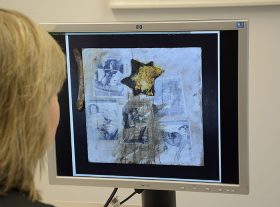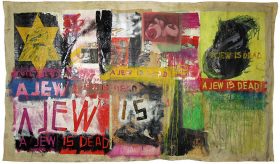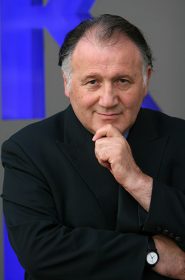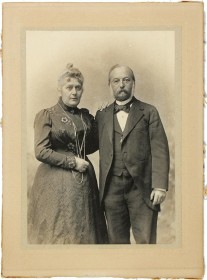
Nina Wilkens contemplating the collage “Found objects on flat cardboard box” on her computer screen; Jewish Museum Berlin, photo: Svenja Kutscher
Five black and white photographs of a scantily-clad woman, legs spread open, in various suggestive poses. The pictures smudged and stuck askew onto white cardboard. On top, a Star of David partly smeared with yellow paint. A brown dildo is fastened next to the cardboard. This constellation of things looks at first glance like useless trash. Objects left on the ground, covered with their share of grime, and now lying here piled on top of one another. This work by Boris Lurie from our current exhibition “No Compromises! The Art of Boris Lurie” (further information about the exhibition on our website) has no name and its date is ambiguous.
When I started thinking, around a year ago, about a pedagogical program on Boris Lurie, I got stuck on this picture as I sat at my computer clicking through images of the works that were being considered for the exhibit. I was confused by my own reaction to this collage of two- and three-dimensional objects: vacillating between disgust and uncertainty. I had the words “obscene” and “tasteless” on the tip of my tongue but found them unsuitable. The image hurt. I wondered how students would react to Boris Lurie’s art. → continue reading
A Conversation with Peter Weibel about whether Boris Lurie Should Be Seen as a Part of the Ultra-realist Neo-avant-garde, and Pornography as a Metaphor for Capitalist Society

Boris Lurie, “A Jew is dead,” 1964; Boris Lurie Art Foundation, New York, USA
Mirjam Bitter, blog editor: As part of the program accompanying our Boris Lurie retrospective, you’ll be giving a lecture at the Jewish Museum Berlin on 30 May 2016 on the subject of “The Holocaust and the Problem of Visual Representation,” (further details of which can be found in our events calendar). Is this tied up with the idea that the Holocaust is a major theme in Lurie’s work?

Peter Weibel
© ONUK
Peter Weibel: The Holocaust, along with war, Hiroshima, and Nagasaki were pivotal traumatic experiences for the post-Second World War neo-avant-garde. Take, for example, Yves Klein’s painting “Hiroshima” (1961) or Joseph Beuy’s environment “Show Your Wound” (1974–1975). Many artists responded to the inhumanity they had witnessed by calling into question humanity and indeed, civilization itself: Why, they asked, had literature, painting, music, and philosophy been unable to prevent this twentieth-century barbarism? → continue reading

Emanuel and Johanna Stern, ca. 1903; Jewish Museum Berlin, gift of Alexander Summerville
Just over two years ago, I penned a blog text describing a Passover Haggada that I had purchased online. It caught my attention due to the lists of names written on the inside front and back covers of individuals who attended the Passover Seders over the course of seven years that were held in two residences in Berlin, both of which were in close proximity to the Jewish Museum Berlin. Research revealed a substantial amount of information about various persons named therein and my text concluded with the hope that contact might be established with descendants of some of those found in the lists.
At the end of March of this year, I flew to Stockholm to visit Alexander Summerville, the great grandson of Paul Aron, in whose home in the Hedemannstraße 13/14 Passover Seders took place in five of the years for which lists exist in the Haggada. → continue reading



